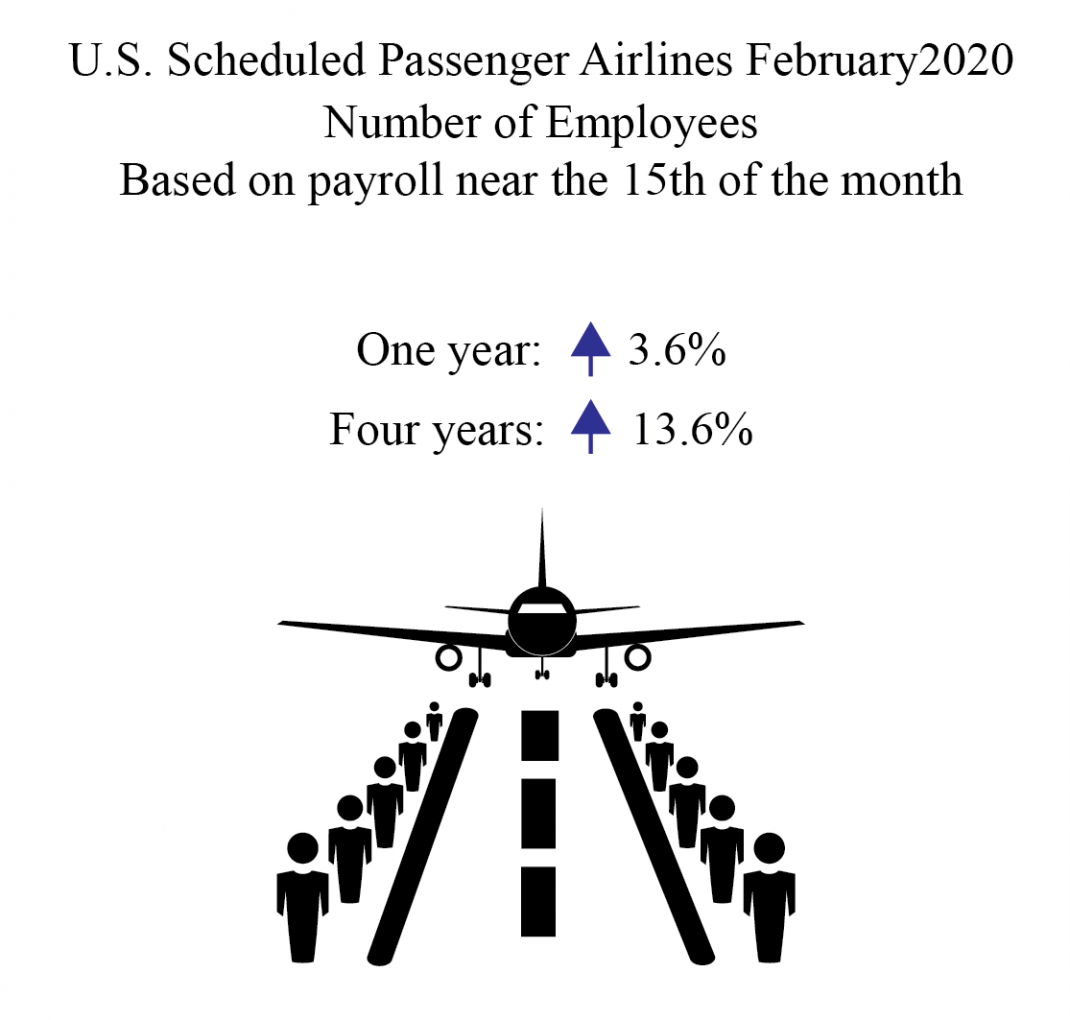February 2020 U.S. Passenger Airline Employment Data

The 22 U.S. scheduled passenger airlines employed 3.6% more workers in February 2020 than in February 2019:
- February’s 458,832 full-time equivalents (FTEs) was up from the previous month’s employment total in January 2020 (456,398 FTEs) and was the highest FTE total for any month since February 2003 (460,852 FTEs).
- February was the 76th consecutive month that U.S. scheduled passenger airline FTEs exceeded the same month of the previous year.
Regulations require U.S. airlines to report employment numbers for employees who worked or received pay for any part of the pay period(s) ending nearest the 15th day of the month. Employment reports are filed monthly with the Bureau of Transportation Statistics. See the tables that accompany this release on the BTS website for detailed data since 2015 (Tables 1-15) and industry summary data since 1990.
Employees at U.S. Scheduled Passenger Airlines Month of February, 1990-2020
| February FTEs in thousands (000) | 1 | |
|---|---|---|
| 1990 | 446.6 | 2 |
| 1991 | 440.6 | 3 |
| 1992 | 442.9 | 4 |
| 1993 | 439.8 | 5 |
| 1994 | 434.3 | 6 |
| 1995 | 428.3 | 7 |
| 1996 | 435.2 | 8 |
| 1997 | 446.1 | 9 |
| 1998 | 461.1 | 10 |
| 1999 | 483.8 | 11 |
| 2000 | 511.0 | 12 |
| 2001 | 534.6 | 13 |
| 2002 | 461.0 | 14 |
| 2003 | 460.9 | 15 |
| 2004 | 435.5 | 16 |
| 2005 | 427.4 | 17 |
| 2006 | 402.8 | 18 |
| 2007 | 406.2 | 19 |
| 2008 | 415.4 | 20 |
| 2009 | 391.6 | 21 |
| 2010 | 378.6 | 22 |
| 2011 | 382.1 | 23 |
| 2012 | 387.2 | 24 |
| 2013 | 380.4 | 25 |
| 2014 | 382.0 | 26 |
| 2015 | 389.0 | 27 |
| 2016 | 403.9 | 28 |
| 2017 | 419.8 | 29 |
| 2018 | 432.2 | 30 |
| 2019 | 443.1 | 31 |
| 2020 | 458.8 | 32 |
| 33 |
FTE calculations count two part-time employees as one full-time employee.
Bureau of Transportation Statistics
All 22 scheduled service passenger airlines
- 458,832 FTEs
- Up 3.6% (15,774 FTEs) from February 2019 (443,058 FTEs)
- Up 13.6% (54,915 FTEs) from February 2016 (403,917 FTEs)
Four network airlines
- 291,557 FTEs, 63.5% of total scheduled passenger airline FTEs
- Up 2.4% (6,787 FTEs) from February 2019 (284,770 FTEs)
- Up 9.2% (24,570 FTEs) from February 2016 (266,987 FTEs)
Network airlines operate a significant portion of their flights using at least one hub where connections are made for flights to down-line destinations or spoke cities. Note that beginning with January 2018 data, Virgin America’s numbers are included with Alaska Airlines in the network category.
Five low-cost airlines
- 98,650 FTEs, 21.5% of total scheduled passenger airline FTEs
- Up 5.1% (4,762 FTEs) from February 2019 (93,888 FTEs)
- Up 24.0% (19,072 FTEs) from February 2016 (79,578 FTEs)
Low-cost airlines operate under a low-cost business model, with infrastructure and aircraft operating costs below the overall industry average.
10 regional airlines
- 59,490 FTEs, 13.0% of total scheduled passenger airline FTEs
- Up 5.6% (3,150 FTEs) from February 2019 (56,340 FTEs)
- Up 18.0% (9,074 FTEs) from February 2016 (50,416 FTEs)
Regional carriers typically provide service from small cities, using primarily regional jets to support the network carriers’ hub and spoke systems.
Top Employers by Group
- Network: American 101,963 FTEs
- Low-Cost: Southwest 61,264 FTEs
- Regional: SkyWest 15,716 FTEs
Other airlines
Other carriers generally operate within specific niche markets. They are: Hawaiian Airlines, Sun Country Airlines and Silver Airlines.
Reporting Notes
Airlines that operate at least one aircraft that has more than 60 seats or the capacity to carry a payload of passengers, cargo and fuel weighing more than 18,000 pounds must report monthly employment statistics.
Data are compiled from monthly reports filed with BTS by commercial air carriers as of April 3. Additional airline employment data and previous releases can be found on the BTS website. BTS has scheduled release of March passenger airline employment data for May 20.
